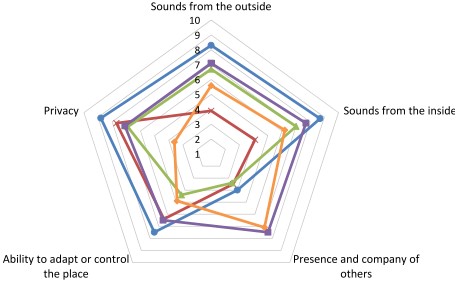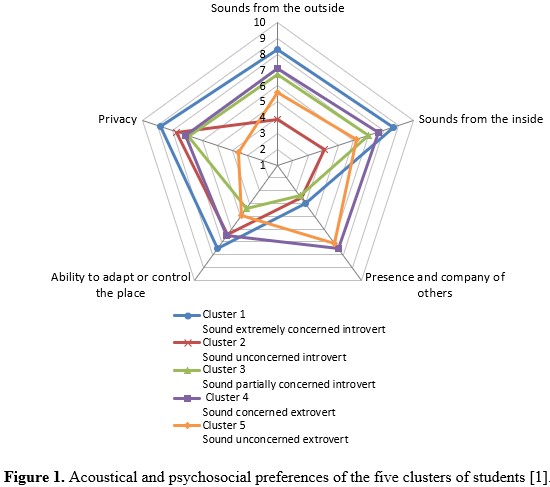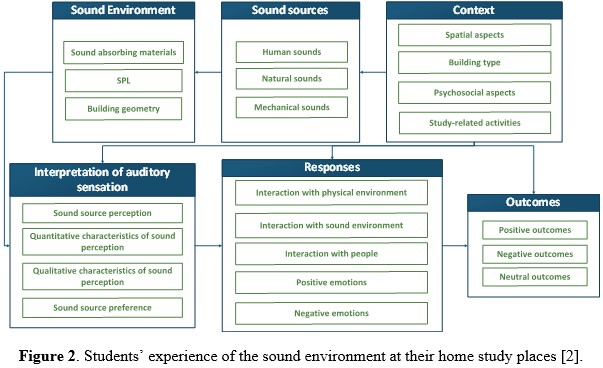
After being inspired by Amneh’s research about students experience of their study soundscapes we caught up for an interview with her and found out more about Amneh and what her broader interests are around her research. Amneh has just recently completed her PhD with TU Delft.
- Name: Amneh Hamida PhD.
- Where do you live: Delft, the Netherlands.
- Company you work for: Delft University of Technology.
- Where do you go to find peace: walking in the woods.
- What’s your favourite sound: birds songs and water fountains.
- How did you end up working with acoustics: I studied part of building acoustics during my bachelor’s degree and enrolled in a workshop regarding acoustical absorption materials during my master’s degree. Also, I am passionate about occupant health and comfort while staying indoors, and acoustics is one of the factors that play a significant role in improving the well-being of students at their study places.
- What acoustics-related challenges do you face: personalised acoustic design is one of the challenges that could match the acoustical preferences and needs of different profiles of students.
- What is it like to work with room acoustics in your country: working with room acoustics depends on the function of the space. For instance, in classrooms, room acoustics will mainly focus on applying acoustical absorption materials and reducing the reverberation time.
- What trends do you see in room acoustics: room acoustics nowadays now focuses on both objective measurements and subjective perception, where indoor soundscapes of different contexts (e.g., study places, classrooms) are being studied to promote the well-being of occupants via focusing on providing wanted (i.e., preferable) sounds of people rather than eliminated noise.

Do all university students prefer quiet and private study places?
University students spend their studying time outside of lectures in study places, known as informal learning spaces, which may be located on campus or at home. In these places, students typically engage in cognitively demanding tasks. The acoustical quality is one of the key indoor environmental quality (IEQ) factors that significantly affect students’ well-being and performance. Therefore, understanding students’ acoustical preferences for their study places is crucial for designing spaces that align with their preferences and needs and promote their well-being. Moreover, university students differ in their acoustical and psychosocial preferences for their study environments. Hence, this study is one of the first attempts to cluster and profile students based on both the acoustical and psychosocial preferences of their study places.
Which methods were applied to cluster and profile the students?
We applied a mixed-methods approach that included both a questionnaire and a field study. The ‘MyStudyPlace’ questionnaire consisted of several sections, including IEQ and psychosocial preferences. A total of 451 university students from the Faculty of Architecture and the Built Environment completed this questionnaire. We then computed a TwoStep cluster analysis to group students with similar acoustical and psychosocial preferences into distinct clusters. The input variables included five preferences: 1) sounds from the outside, 2) sounds from the inside, 3) ability to adapt or control the place, 4) privacy, and 5) presence and company of others.
Next, we visited 23 home study environments and interviewed 23 students, all of whom had completed the questionnaire and belonged to the five different clusters. During the visits, we conducted building inspections and measured the sound levels at their home study places. The field data helped us gain a deeper understanding of why students differ in their acoustical preferences and how building-related factors might influence these preferences.
What were the findings?
We found five clusters of university students, as illustrated in Figure 1: 1) sound concerned introvert, 2) sound unconcerned introvert, 3) sound-partially concerned introvert, 4) sound concerned extrovert, and 5) sound unconcerned extrovert. These clusters revealed that being an introvert does not necessarily mean a preference for a quiet study place, nor does being an extrovert imply a preference for studying with background noise.
The field study provided insights into the aspects influencing students’ acoustical preferences. For example, students in the ‘sound concerned’ clusters were bothered by loud noises from the outside, such as traffic, and expressed their high concerns about the sounds from the outside. In contrast, students who were not concerned about sound had become habituated to both sounds from the outside and inside. Additionally, it is noteworthy that some students’ acoustical preferences changed after relocating to a new study place, showing that the building’s location plays a significant role in influencing acoustical preferences. For instance, two students became less concerned with the sounds from the outside because their current study space was quiet, whereas their previous one was located near a busy road.

What is recommended?
Since this study confirmed that students have different acoustical and psychosocial preferences for their study environments, designing a study space for the ‘average’ student may not meet the needs and preferences of all students. Therefore, it is strongly recommended to design study spaces that are tailored to the diverse acoustical and psychosocial preferences of different student profiles.
To what extent can the indoor soundscape approach be used to assess the sound environment experience of each student at home study place?
The indoor soundscape approach has been studied within the context of different sound environments, such as classrooms and libraries, to understand how an individual experiences the sound environment in a context. Yet, little is known about how university students experience the sound environment of their study places.
Which methods were applied?
Semi-structured interviews with 23 university students at their home study places were conducted. We asked the students several questions regarding how they experienced the sound environment of their study places regarding the present sound sources at their study places, what they do when they are exposed to these sounds, and which sound source they prefer to listen to while studying. Then, we analysed the data qualitatively and validated it via two workshops with PhD students.
How do students experience the sound environment at their study places?
The indoor soundscapes of university students’ home study places are represented in an affinity diagram (see Figure 2), which includes six soundscape themes: context, sound sources, sound environment, interpretation of auditory sensations, responses, and outcomes. These are further divided into 22 categories. The 80 sub-categories of the 22 categories are detailed in the reference [2]. The soundscape approach contributes to understanding how occupants experience their sound environment in a given context by examining their interpretations, responses, and outcomes related to specific sound sources. We found that the ‘context’ theme, such as spatial aspects (e.g., the study place is close to a window), influenced two other themes: sound sources and the interpretation of auditory sensations. For example, one student’s study area faced a roadside, which affected their perception and preference regarding sound sources. This approach also allows for exploring the continuous exposure to sound sources that students experience, as well as the sound sources they prefer while studying. Our findings showed that most university students were exposed to sounds produced by people. However, their preferences varied, with some students preferring this sound source while others did not. Additionally, the soundscape approach revealed how students cope with the sound environment at their home study place. More than half of the students used headphones or earbuds to block out unwanted sounds ‘noise’. Therefore, the indoor soundscape approach can contribute to better design of the indoor sound environment of study places by accounting for occupants’ positive sound experiences.

What is the connection to the five clusters?
The indoor soundscape approach accounts for an ‘average’ student, without accounting for individual differences among students. For instance, the most dominant sound source identified as ‘people talking or moving’ sounds. Interestingly, in our study, students had different preferences for these sounds: five students did not prefer the presence of people sounds, while three students did. Also, students differed in their responses (i.e., coping methods) when exposed to ‘annoying’ sounds. Some students interacted with the sound environment by using headphones or earbuds, while others adjusted their physical environment by closing a window or door. These findings highlight that students experience the sound environment at their study places differently, in terms of preferences, perceptions, and coping methods. In the context of study spaces and learning environments, students have varying preferences and needs. It was confirmed that students can be grouped based on these preferences and needs, resulting in distinct profiles. A previous study [1] identified five profiles of university students based on their acoustical and psychosocial preferences.
References:
This blog is related to the scientific article published in Building and Environment journal:
- Hamida, A., Eijkelenboom, A., & Bluyssen, P. M. (2024). Profiling university students based on their acoustical and psychosocial preferences and characteristics of their home study places. Building and Environment, 253, 111324. https://www.sciencedirect.com/science/article/pii/S0360132324001665.
- Presented paper in the 53rd International Congress & Exposition on Noise Control Engineering (inter.noise 2024): https://research.tudelft.nl/en/publications/assessing-the-indoor-soundscape-approach-among-university-student.

